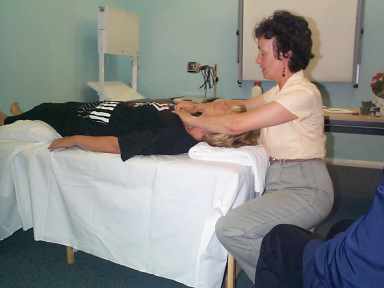
by Joe Sinclair
I
recently came across an article about the Bowen Technique and its successful use
in Bosnia when employed by a practitioner[1] who went there with the Healing
Hands Network. My mind instantly
shot back five years to a demonstration of the technique that I had attended at
a monthly meeting of the Dorset Association of Complementary Practitioners (DACP)
- now, alas, defunct.
One
of our members, Diane Kendrick, described how this gentle method of treating
muscular problems had been developed by Australian Tom Bowen, who at one stage
was treating upwards of 13,000 patients a year, the majority of whom required no
more than two or three treatments. Surprisingly,
despite the success rate for treatments, there are fewer than 2000 practitioners
of this technique in the world and more than one-third of them are located in
Britain.
The
Bowen Technique involves a sequence of light pressure movements of the
practitioner’s fingers and thumbs over the skin of the patient, at precise
locations. There is a basic
treatment, with “add-ons” for particular conditions such as frozen shoulder,
tennis elbow, or strained hamstrings. It
was my own frozen shoulder disability – that I endured for almost two years,
despite a variety of treatments from standard physiotherapy to acupuncture - that
roused my interest in Diane’s presentation.
I
still have on my computer the report on the presentation that I recorded in the
DACP newsletter for that quarter.[2]
It
notes that Tom Bowen did not allow any one else to teach the technique until
after his death, so it was not until 1980 that it became more widely taught.
Bowen Technique has some
important bonuses for clients. Ideally
the client is lying down but this is not essential.
Also there is generally no need to undress as all the basic moves are
performed through clothes (although it may be easier to treat some areas of the
body if some clothes are removed).
So many of us work with energy
in different ways and I particularly liked the following analogy. “One
possible theory of the underlying mechanism of
the ‘Bowen Technique’ is the resonance model demonstrated by stringed
instruments. A string held and
played at a particular point will establish a resonance that creates a
distinctive tone. Changing the
point where the string is held creates a vibrational pattern that correlates
with a specific frequency. . . Just
as a string must be played carefully to create the required sound, so must the
structures of the body be activated correctly to effect a full response”.

Diane Kendrick's demonstration - total relaxation for practitioner and subject
Watching Diane work, it was
clear that she used a very gentle technique with small rolling movements being
made on the surface muscles of the body and the similarity of plucking a
stringed instrument could be seen. The
pressure used in a treatment varies from firm to very light and it is important
that these moves, as they are known, are performed carefully and precisely and
that the therapist does not over-treat. The
moves allow relaxation of the muscle to take place; some also divert the energy
flow within the body and Diane told us that she feels this as a small electrical
charge. A vital part of the
technique is that the practitioner makes several moves and then leaves the room
in order to allow the energy to settle before returning to do another sequence
of moves. During a typical
treatment of an hour there may be several breaks of two minutes or more.
Diane said it is recommended
that the client receives no other form of body work at the same time as Bowen in
order not to confuse the messages that are being sent to the brain, although flower remedies and homoeopathy work well alongside the technique. It seems that
the practitioner is working at both physical and energy levels and the effect on
the patient, as with so many complementary therapies, is on the physical, mental
and emotional planes.
![]()
[1] Tim Willcocks
[2] Readers wishing to view the original article can find it in pdf format by clicking here.